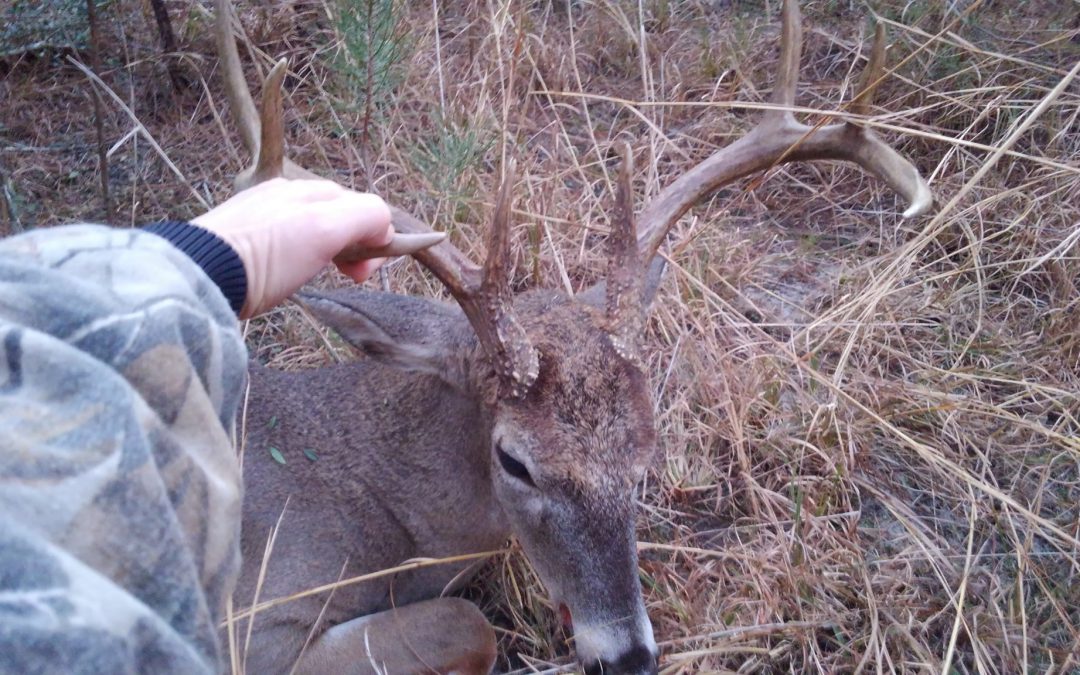
by Jennifer Bearden | Jan 31, 2019
This time of year in Northwest Florida, deer hunters are busy talking about the rut! What’s the rut, you might ask? Simply put, it’s deer breeding season. Deer hunters speculate on peak rut times each year. There are even peak rut forecasts. Why are hunters interested in deer rut? Hunters know that bucks are more active and careless during the rut.
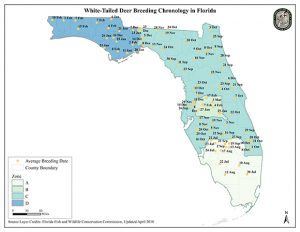
Deer Breeding Chronology in Florida May 2018. Source Florida Fish and Wildlife Commission
Bucks exhibit four rut behaviors: sparring, rubbing, scraping, and chasing. Sparring happens between bucks to establish dominance. This happens during the pre-rut. Dominant bucks are generally the ones who get the does. Bucks also make rubs on trees during the pre-rut period. They start this behavior to remove velvet from their antlers. They continue rubbing to mark their territory with their scent. Scraping is another way they mark their area. A scrape normally occurs under a low hanging branch. The buck will lick or chew on the branch while scraping the ground as well as urinating on the ground. The last rut behavior is chasing does. Does typically won’t be game for this unless they are ready to breed.
In other parts of the country, the rut is long over. Even in other parts of Florida, it is over. Florida has more variability in rut timing than in any other state. In Florida, deer rut starts in July in the southern part of the state and runs through February in the north. Deer breeding dates are more predictable in the northern U.S. where winters are too harsh for fawn survival. Deer breeding in our state is more variable because of our mild winters. Average breeding dates in Northwest Florida are very late compared to other parts of the country and the state. Our average breeding dates generally range from December to mid-February. Gestation takes about 200 days, so this puts fawning dates in late June through early September.
Even though we have average breeding dates for our area, these aren’t “magical dates”. Not all does go into estrus on the same day or even the same week.

8 point buck taken in Northwest Florida in January while chasing a doe. Photo credit: Jennifer Bearden
Estrus only lasts 24 hours and not all does become pregnant during the first estrus period. This means that about 28 days later does go into a second estrus. So the rut period is a range around the average date.
So, to all my fellow hunters in Northwest Florida, enjoy the 2019 rut! I know I have enjoyed watching several bucks chase does as well as having the opportunity to take the biggest buck of my life this January. Good luck to you all in your hunting ventures!
More information about the Florida Fish and Wildlife Commission Deer Breeding Chronology Study can be found at https://myfwc.com/hunting/deer/.
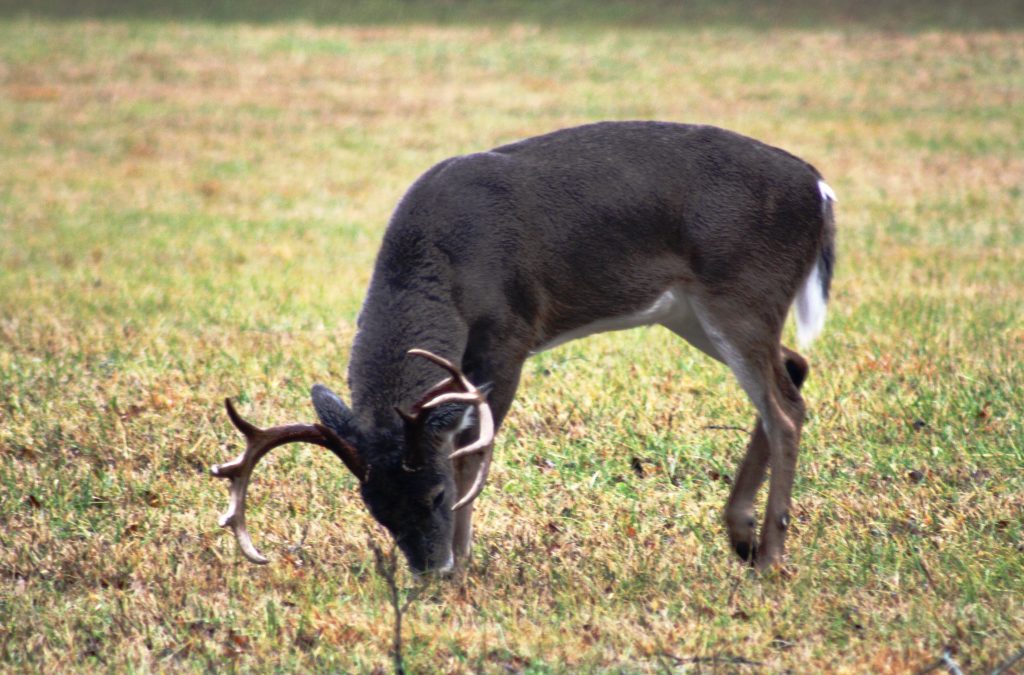
by Shep Eubanks | Sep 12, 2018
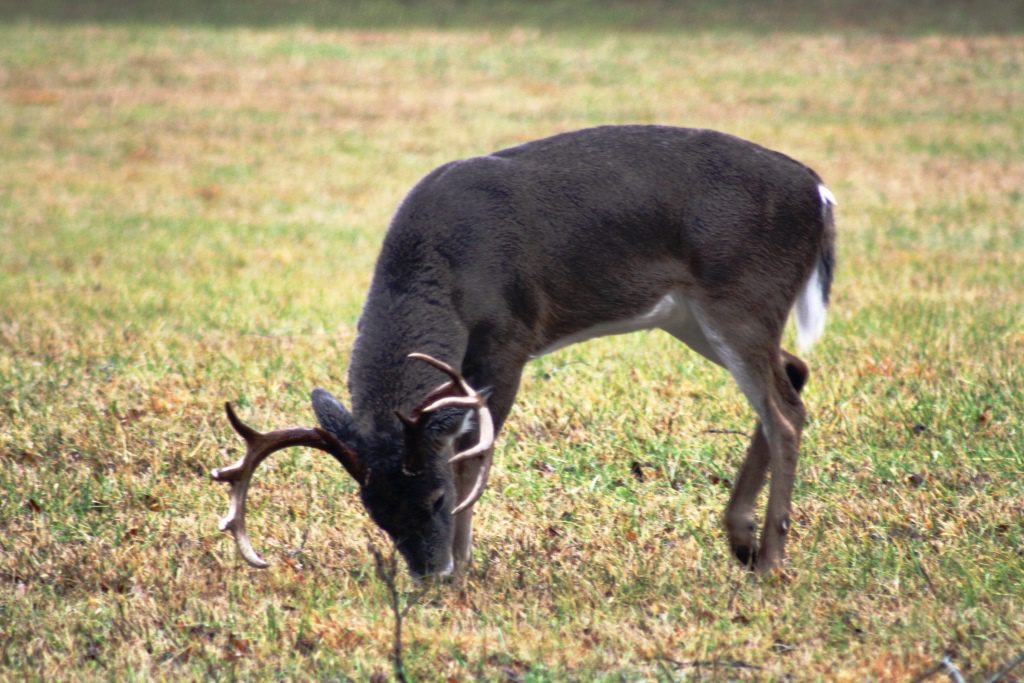
North Florida buck feeding on acorns at the edge of a food plot. Photo Credit – Shep Eubanks UF/IFAS
It’s that time of year when landowners, hunters, and other wildlife enthusiasts begin to plan and prepare fall and winter food plots to attract wildlife like the nice buck in the photo.
Annual food plots are expensive and labor intensive to plant every year and with that thought in mind, an option you may want to consider is planting mast producing crops around your property to improve your wildlife habitat. Mast producing species are of two types of species, “hard mast” (oaks, chestnut, hickory, chinkapin, American Beech, etc.), and “soft mast” (crabapple, persimmon, grape, apple, blackberry, pears, plums, pawpaws, etc.). There are many mast producing trees and shrubs that can be utilized and will provide food and cover for a variety of wildlife species. This article will focus on two, sawtooth oak (or other oaks) and southern crabapple.
Sawtooth Oak
Oaks are of tremendous importance to wildlife and there are dozens of species in the United States. In many areas acorns comprise 25 to 50% of a wild turkeys diet in the fall (see photos 1, 2, and 3) and probably 50% of the whitetail deer diet as well during fall and winter. White oak acorns average around 6% crude protein versus 4.5% to 5% in red oak acorns. These acorns are also around 50% carbohydrates and 4% fat for white oak and 6% fat for red oak.
The Sawtooth Oak is in the Red Oak family and typically produces acorns annually once they are mature. The acorns are comparable to white oak acorns in terms of deer preference as compared to many other red oak species. Most red oak acorns are high in tannins reducing palatability but this does not seem to hold true for sawtooth oak. They are a very quick maturing species and will normally begin bearing around 8 years of age. The acorn production at maturity is prolific as you can see in the photo and can reach over 1,000 pounds per tree in a good year when fully mature. They can reach a mature height of 50 to 70 feet. There are two varieties of sawtooth oak, the original sawtooth and the Gobbler sawtooth oak, which has a smaller acorn that is better suited for wild turkeys. The average lifespan of the sawtooth oak is about 50 years
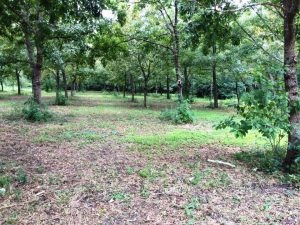
Photo 1 – Seventeen year old planting of sawtooth oaks in Gadsden County Florida. Photo Credit – Shep Eubanks UF/IFAS

Photo 2 – Gadsden County gobblers feeding on Gobbler sawtooth oak acorns
Photo Credit – Shep Eubanks UF/IFAS
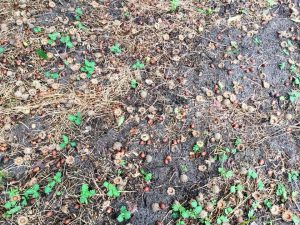
Photo 3 – Gobbler sawtooth oak acorns in Gadsden County. Notice the smaller size compared to the regular sawtooth oak acorn which is the size of a white oak acorn.
Photo credit – Shep Eubanks UF/IFAS
Southern Crabapple
Southern Crabapple is one of 25 species of the genus Malus that includes apples. They generally are well adapted to well drained but moist soils and medium to heavy soil types. They will grow best in a pH range of 5.5 – 6.5 and prefer full sun but will grow in partial shade as can be seen in photo 4. They are very easy to establish and produce beautiful blooms in March and April in our area as seen in photo 5. There are many other varieties of crabapples such as Dolgo that are available on the market in addition to southern and will probably work very well in north Florida. The fruit on southern crabapple is typically yellow green to green and average 1 to 1.5 inches in diameter. They are relished by deer and normally fall from the tree in early October.
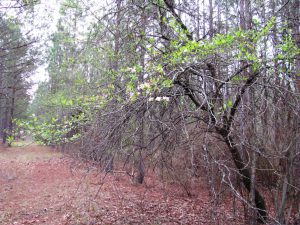
Photo 4 – Southern crabapple tree planted on edge of pine plantation stand. Photo taken in late March during bloom.
Photo credit – Shep Eubanks UF/IFAS
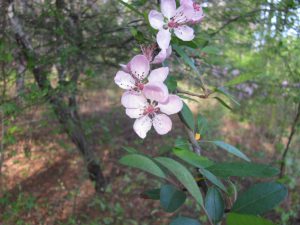
Photo 5 – Showy light pink to white bloom of southern crabapple in early April during bloom.
Photo credit – Shep Eubanks UF/IFAS
A good resource publication on general principles related o this topic is Establishing and Maintaining Wildlife Food Sources.
If you are interested in planting traditional fall food plots check out this excellent article by UF/IFAS Washingon Couny Extension Agent Mark Mauldin: Now’s the Time to Start Preparing for Cool-Season Food Plots .
For more information on getting started with food plots in your county contact your county’s UF/IFAS Extension Office
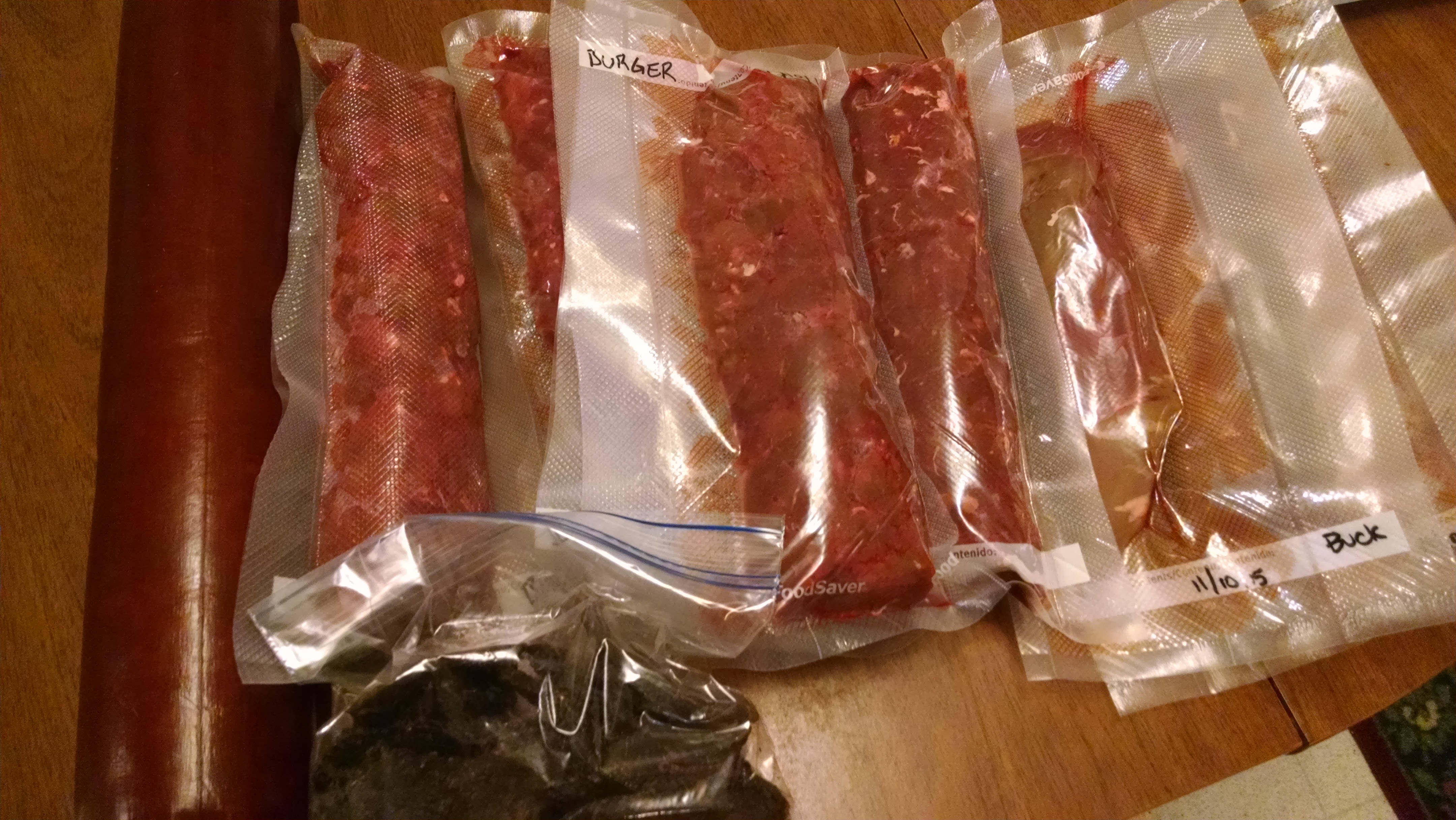
by Jennifer Bearden | Nov 18, 2016
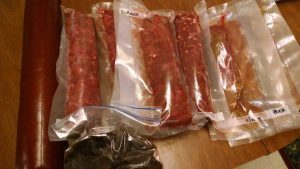
Freshly processed venison. Photo credit: Jennifer Bearden
When hunting, food safety begins in the field. The goal is to have safe meat for you and your family to eat. Here are a few ways to keep your food safe:
- Shot placement – that’s right. Food safety begins with an accurate shot. Your goal should be to prevent the contents of the digestive tract from touching the meat. A gut shot can quickly ruin meat and make cleaning the animal harder.
- The quicker you get the meat chilled the better. Improper temperature is meat’s number one enemy. The recommended storage temperature to prevent bacterial growth is 35-40°F.
- Handle the knife with one hand and the carcass with the other. The hide can harbor dirt and pathogens so care should be taken to prevent contamination of the meat.
- Have vinegar water and chlorine water on hand. Vinegar water (50/50) can be sprayed on areas where hair or hide touch the meat. Rinse hands and tools periodically in a bucket of sanitizing solution of 1 tbsp of chlorine per gallon of water.
- Think food safety through the whole process. Prevent cross contamination by keeping anything from contacting the meat unless it has been sterilized. Keep the digestive tract intact and prevent the contents of it from contacting the meat. Chill the meat as quickly as possible. When further processing, continue to use sterile surfaces and tools.
Many hunters age deer meat to increase tenderness and improve flavor. This is safe if done properly. There are two ways to safely age meat. Dry aging in a walk-in cooler or refrigerator is the best but not feasible for all hunters. The walk-in cooler or refrigerator must be clean and have good air circulation and proper temperature control (34-38°F). The meat can aged for 7-21 days depending on the amount of moisture in the cooler. Too much moisture can increase microbial growth on the meat which should be cut away before further processing. There will also be a layer of dry meat that will need to be cut away.
An ice chest can also be safely used to age meat. First, fill the clean ice chest with ice and water. Add meat immediately to ice water and soak for 12-24 hours. This will quickly cool the meat to the proper temperature. Then drain the water out of the cooler and add more ice. Keep cooler drained of water and full of ice for 5-7 days. There may be “freezer burn” on the outside of the meat that can be cut away before further processing.
Remember food safety when further processing and storing. Wild game food safety begins in the field and ends with consumption.
For more information about safe handling of venison:
http://www.noble.org/ag/wildlife/propercareofvenison/
http://www.clemson.edu/extension/hgic/food/food_safety/handling/hgic3516.html
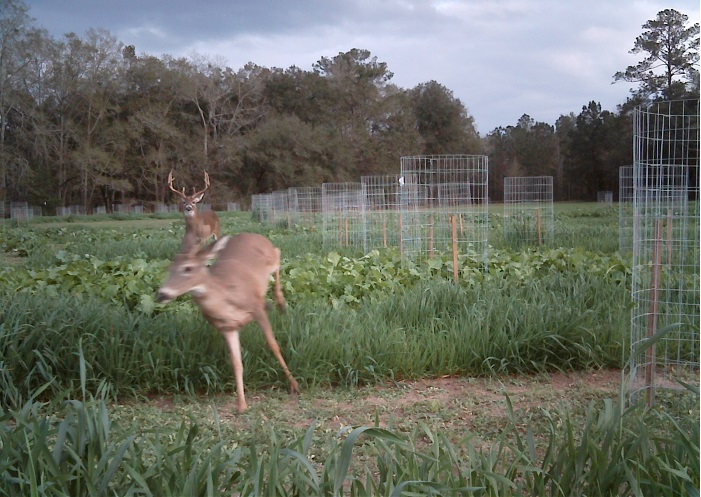
by Mark Mauldin | Nov 7, 2016

A buck chases a doe through plots of wildlife forages being evaluated in 2013 at the University of Florida’s North Florida Research and Education Center. Photo Courtesy of Holly Ober
It should be too late in the year for an article about cool season food plots; they should already be up and growing, at the very least planted. It’s November, archery season has begun, the fall food plot ship should have already sailed. However, due to the incredibly dry weather we’ve had for the past several months I hope that ship hasn’t sailed. I hope you have not planted your food plots yet. The tristate area is dry, too dry to plant anything you expect to survive. If you have not already planted, don’t until your area gets substantial rain.
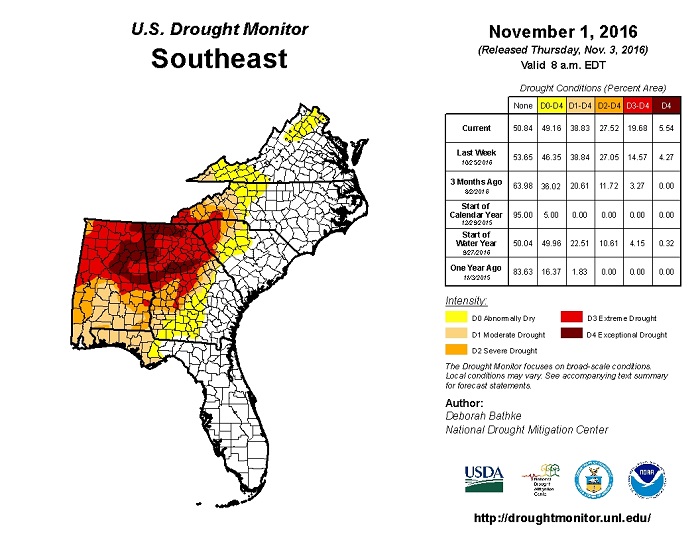
Very dry conditions persist across the Southeast.
The saying goes “The best time to go hunting is whenever I have time”. As the classic weekend-warrior sportsman myself, I can easily relate to that saying and I can also understand how/why folks would apply that same logic to planting food plots. Unfortunately, with this fall’s weather that logic does not hold true. Any plantings made before we have adequate moisture run a very high chance of being complete failures.
These likely failures can playout in a variety of ways but they all end the same. Seedlings have tiny roots systems, moisture must be accessible very near the soil surface in order for them to access it. If moisture is unavailable in the tiny root zone the seedlings will wilt. Wilting greatly diminishes the plants ability to carry out photosynthesis; no photosynthesis no energy. Seedlings have virtually no stored energy to fall back on, so the seedlings begin to die rapidly.
Admittedly, I left out one key detail in the plant horror story above; moisture is required for seed germination. If it is dry enough seeds can be planted and nothing will happen – they won’t germinate, they won’t try to grow, they won’t die from lack of moisture. This fact leads some to conclude, “Plant now and it will come up whenever it rains”. While there is some sound logic in that conclusion, it is a very risky plan when you consider the types of plants we typically include in our wildlife plots. “Dusting in” as it is called in the crop world, can work with larger seeded, deeper planted crops. It is not well suited to small seeded, very shallow planted forages like clover. When a seed is right at the soil surface the tiniest amount of rain or even a heavy dew could provide enough moisture for germination which would likely start the process I described earlier.
The safest bet is to wait until your area has received a good soaking rain and there is a favorable chance for additional rains. As dry as we are now, that first ½ inch shower will not provide adequate moisture for establishment if it is followed by an extended period without additional rain.
Sooner or later it will rain (I think), so you wind up planting your plots later than normal. What does that mean? In the grand scheme of things, not much. As we get later in the year the days get shorter and the air and soil temperatures get lower which can slow the development of the plants. That said, the real growth for most of our cool season forages really occurs in the spring and that will still be that case regardless of if you planted in October, November or December. Remember the goal of food plots should be increasing the quality and quantity of forage available for wildlife throughout the entire year.
The dry weather has messed up food plot establishment as it relates to hunting season but if all you wanted was a game attractant for hunting purposes food plots were probably not your best bet in the first place. It takes considerable time, effort and expense to maintain quality food plots, to the point that they are really not a very practical option if only viewed as an attractant for a few months out of the year.

If attracting deer, not improving habitat, is your primary goal you might consider establishing a feeding station. Be sure to check FWC regulations before you begin feeding game animals.
Be patient, wait for the weather conditions to improve before planting. There is no point in wasting your time and money on plantings that have a very low chance of being successful. Contact your county’s agriculture or natural resources agent for more details relating to the establishment of wildlife plots.
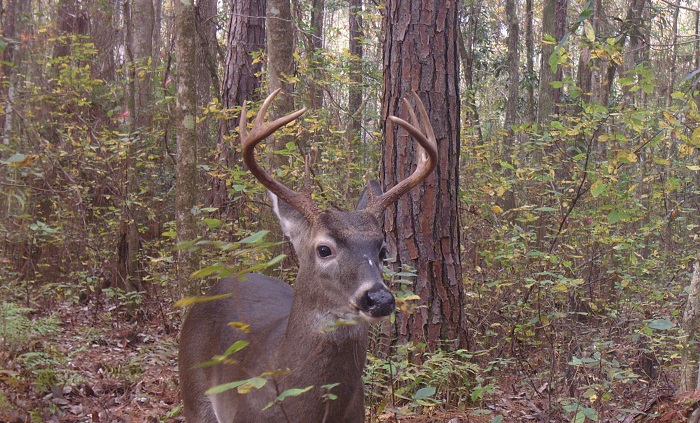
by Jennifer Bearden | Oct 31, 2015
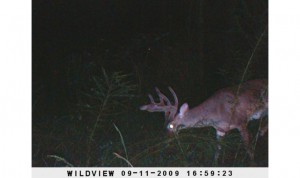
Deer in velvet. Photo by Jennifer Bearden
When hunting, food safety begins in the field. The goal is to have safe meat for you and your family to eat. Here are a few ways to keep your food safe:
- Shot placement – that’s right. Food safety begins with an accurate shot. Your goal should be to prevent the contents of the digestive tract from touching the meat. A gut shot can quickly ruin meat and make cleaning the animal harder.
- The quicker you get the meat chilled the better. Improper temperature is meat’s number one enemy. The recommended storage temperature to prevent bacterial growth is 35-40°F.
- Handle the knife with one hand and the carcass with the other. The hide can harbor dirt and pathogens so care should be taken to prevent contamination of the meat.
- Have vinegar water and chlorine water on hand. Vinegar water (50/50) can be sprayed on areas where hair or hide touch the meat. Rinse hands and tools periodically in a bucket of sanitizing solution of 1 tbsp of chlorine per gallon of water.
- Think food safety through the whole process. Prevent cross contamination by keeping anything from contacting the meat unless it has been sterilized. Keep the digestive tract intact and prevent the contents of it from contacting the meat. Chill the meat as quickly as possible. When further processing, continue to use sterile surfaces and tools.
For more information on wild game processing safety, you can attend our upcoming Wild About Deer: Game Processing Program on November 14 from 10am to 2pm. We will teach processing safety from field to table. A home-cooked venison meal will be provided. The cost is $20. Please pre-register by calling 850-689-5850.
Wild about Deer Flyer

by Mark Mauldin | Aug 21, 2015

Deer hunting season is just around the corner. It’s time to start scouting and making preparations to plant cool season food plots. Photo Credit: Mark Mauldin
The temperature might still be in the 90s but the kids are back in school and football season is starting soon; that means fall is coming and with it, the beginning of hunting season. Here in northwest Florida archery season for deer and turkey begins October 24. While it might still be a little early to dust off your camouflage there are still plenty of things you can be doing this time of year to get ready for the start of hunting season.
If plan to utilize food plots on your hunting property this fall it is time to take soil samples and if need be, apply lime. All plants have a soil pH range where they grow best. For many of the plants we commonly use in food plots the ideal range for soil pH is above that of our soils here in Florida. Applying lime to the soil will increase the soil pH, but it takes time; months not weeks. There are a variety of liming products available but the most economical option is generally bulk, agricultural or dolomitic lime. Ideally lime would be incorporated into the soil well before planting. A soil test will provide specific recommendations about how much lime and fertilizer your site needs. Your county extension agent can assist you in submitting a soil sample for analysis and interpreting the results and recommendations. Soil pH greatly effects soil nutrient availability; spending money on fertilizer without checking or correcting the pH is not advisable.
It is still early to plant cool season food plots; planting should begin around October 1. It is not too early to begin researching what you want to plant and booking seed. If you are particular about what varieties you want to utilize (you should be) you should make arrangements with seed suppliers in advance. Always be sure to utilize crops and varieties that are well suited to your site. Be careful with premixes that are sold at chain stores. These products may not be well suited to our environment here in Florida. Contact your county agent and be on the lookout for future articles for more information on selecting the forage crops that are best suited to your area.
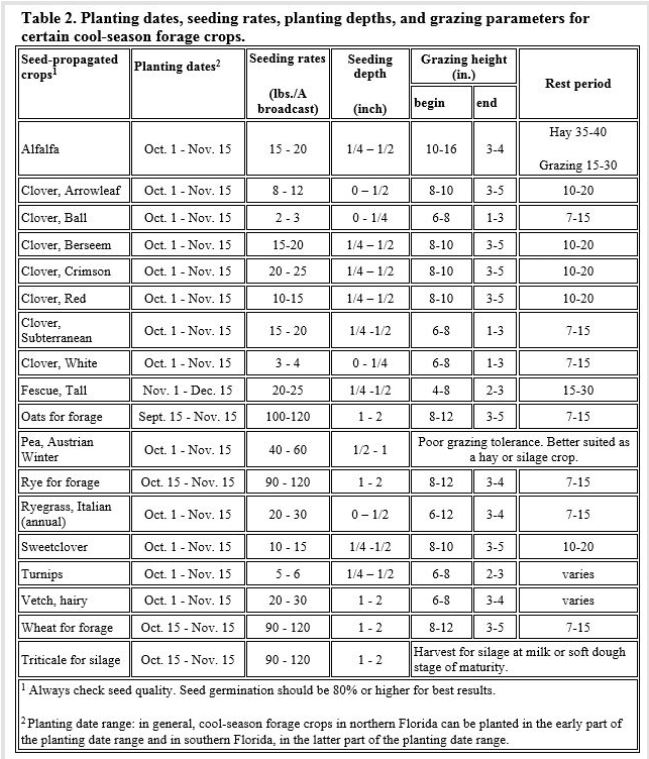
Chart from: 2015 Cool-Season Forage Variety Recommendations for Florida
By; Ann Blount, Patricio Munoz, Jose Dubeux, Joao Vendramini, Ali Barbar, Kevin Kenworthy, and Ken Quesenberry
If you are planning on hunting over feed (corn, etc.) you should have already began your feeding program. To legally hunt over feed the feeding station must have been maintained with feed continuously for at least six months prior to harvest game in the vicinity. In other words, if you start feeding corn today (8/20) you can’t legally hunt over it until February 20th. For more information regarding hunting over feed see the FWC webpage.
Using game cameras to monitor your property can help you get an idea about the quantity and quality of animals utilizing your property. Having this information before hunting season can help you plan management decisions in advance. Preseason scouting, on foot or with game cameras can also help you determine what parts of your property game are utilizing the most. Granted, there is still plenty of time for patterns to change before hunting season gets here. Another positive aspect of utilizing game cameras this time of year is that they give you an added excuse to spend a little extra time in the woods. In the months leading up to hunting season going to “check cameras” is somewhat of a Sunday afternoon tradition in my house.
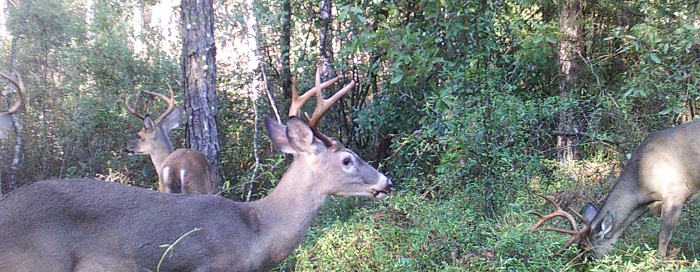
Dense summer foliage and a bachelor group of NW Florida bucks can make for a fun game camera photo. How many bucks can you find? Photo Credit: Mark Mauldin
Long summer days give you plenty of time in the evenings to practice shooting your bow. Proficiency with a bow takes practice and repetition. I was once told, “Don’t practice until you can hit what you’re aiming at, practice until you can’t miss”. Practice now, don’t wait until you miss, or worse, wound an animal to realize you needed to improve your skills. In addition to working on your skills for hunting season, archery can be great outdoor fun for the entire family.
There are a lot of hot days to wait through still ahead of us but hunting season is coming; if you’re like me you’ll be happy to see it when it gets here. Now is the time to make plans and preparations so when the waiting is finally over you’ll be able to have your best season yet.




















